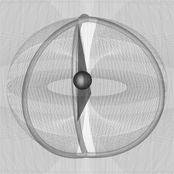



































conceptual inquiry regarding meaning » intelligibility » activity
By way of subjectivity, we come to know how experience affects us. By way of objectivity, we come to know how we might affect experience. Seamlessly fusing together these two modes of intelligibility is the subtlest of the three—the mode of activity—by way of which we come to know how to skillfully navigate practical experience. Grounding this mode of intelligibility is the experience of flow, where flow is understood broadly as occurring anytime we effectively interact with the world. Walking without falling over, inserting food into our mouths rather than hitting the sides of our faces, turning a knob to open a door—all of these are examples of achieving seamless, skillful interaction with the world. It's skill in these basic practices that first articulates a world in terms of practical relevance, and it's the consistent engaging in activities like these that perpetually breathes significance into worlds, keeping them open to intelligibility.
Active intelligibility places experiencer as self in dialogue with experienced as world on the common ground of practical experience as attended to by experiencing as dynamic, a mode of rhythmic attending toward know-how. In the top image to the right, active intelligibility is depicted as a centered cone opening away. The cone's base appears as a cirlce, and its apex falls at the center of the circle. Click A-phase correlation below the image to see the elements of active intelligibility, the colors of which correspond to the items in this table:
| N | activity: rhythmic attending to practical experience, toward skillful knowledge (know-how) |
| experiencer as self = a particular, contextualized point of view, the nature of which is self-determining (an agent) | |
| experiencing as dynamic = attending in a rhythmic mode, skillfully moderating a flow state reconciling parts and wholes | |
| experienced as world = the significance of that which is experienced, relative to a context; a salience landscape (arena) |
Different types of activities can occur in experiencing as dynamic. From the dynamic of a simple organism probing its environment to the dynamic of a theoretician probing his conceptual schema, it's the probing that identifies the contours of a world. It's the activity that serves to articulate the meaningful context within which truth can be skillfully known. When such knowledge is achieved in a flow state, the boundary between self and world breaks down as they intermix in a domain of significance. Experiencer becomes an active agent engaged in an arena, and all self-consciousness falls away. The arena itself is simply a field of significance (as relevant to purposive, practical activities). Both experiencer and experienced are caught up in the same movement, the same flow.
The word rhythmic is used for a couple reasons (even though there may be a better word). First, the skillful knowledge toward which it tends is linked to habit, and insofar as habits are repeated consistently, they might be thought of as rhythmic in a broad sense. Second, the activity involved in this mode of intelligibility is always basically dialogical. Caught up in action, an experiencer makes sense of his foregrounded experiences as they appear against (as compared with) the way he's already familiar with experience (his background), yet the foregrounded experiences update this background such that both foreground and background are both changing through their back-and-forth dialogue. This rhythm can be thought of as occurring between foreground and background; or, as self and world are analogous to foreground and background, it can be thought of as the process whereby self and world are rhythmically reconciled. (See W1 for how this dynamic is graphically represented.) The process is hermeneutic.
